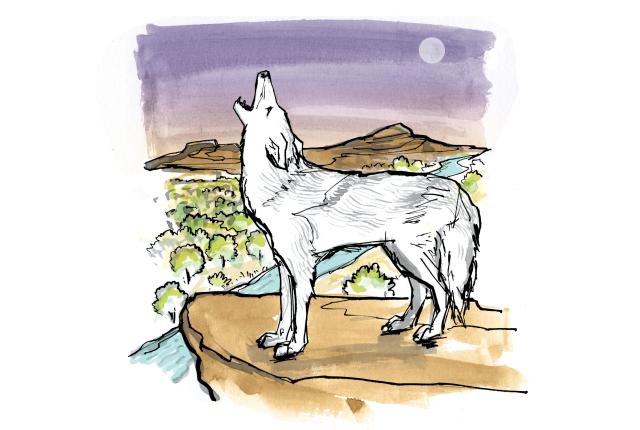Above: Illustration by Brett Affrunti.
The realization often hits me around dusk, as the water travels through the acequia and the embers in the campfire crackle. From their lair down by the Pecos River, all the way across the alfalfa fields, the coyotes start their night songs. Their symphony of howls and yelps echoes through the valley, as if these tricksters were laughing just a little at the world.
When I was growing up in the village of El Ancón, I didn’t pay much attention to the night skies. Sure, I’d sleep outside during the Perseids each summer, awed by how the prolific meteor shower brought the constellations to life. I heard the coyotes, the occasional owl, the acequia’s rush after the thunderstorms of monsoon season, and took these things for granted.
The star I followed led me to other places. First to college back East, then to Los Angeles and New York, then to cities in Latin America where I was posted as a foreign correspondent. But whether I was living in São Paulo or Caracas or Brasília, I always made it back to El Ancón once a year.
These trips aroused some bemused reactions. Even New Mexican friends would ask, “El Ancón? Where’s that?” “Metropolitan Ribera,” I’d reply, mentioning the village next door where mail is delivered. I’d smile at the fact that my corner of northern New Mexico, not far from the southern end of the Sangre de Cristo Mountains in San Miguel County, remained relatively obscure.
El Ancón’s status hasn’t changed much since I moved back to New Mexico. And while I’m now based in Albuquerque, that’s fine with me. I still make it back, and summer ranks as my favorite time to go.
Of course, the main draw is my parents, Nicasio and Janet Stein Romero, who still live in El Ancón in the sprawling old adobe home they knocked together New Mexico–style, starting with a few rooms built more than a century ago, then crafting an addition here, a porch there.
They’re artists, and their work adorns the walls in addition to the hundreds of pieces they picked up in their travels.
I always hope that some of this artwork casts a spell on my kids. But the tug of the outdoors also remains strong for Lucas, 14, and Tomás, 11. Around the house, their grandfather needs firewood chopped and appreciates it when they trek to the river to thin out the groves of Siberian elms.
The road through the valleys along the Pecos winds through villages including El Ancón, San Miguel, Pueblo, and Sena. As we pile into the truck, the sandstone bluffs of Villanueva beckon. The state park outside the village, originally founded more than two centuries ago as La Cuesta, features some of the best hiking, fishing, and camping of the Southwest. The surrounding hills also showcase New Mexico’s history.
A sign on the mesa above Villanueva reminds those who make the climb that this was the place where New Mexicans captured members of the George F.X. Van Ness unit of the Texas invasion of 1841.
The sense of tranquility atop the mesa in Villanueva stands in contrast to that earlier era’s upheaval. As the clouds drift into their slow dance in the vast skies of New Mexico, the landscape of the West comes into focus. On a clear day, hikers can glimpse buttes such as Starvation Peak in the distance. Squint a bit more and there’s the opening of the Great Plains.
A fitting reward for making the climb is a stop at the Villa-nueva General Store, which features what are arguably the best Frito pies in New Mexico and, of course, friendly conversation with villagers and visitors just passing through. Some nourishment is needed before getting back in the truck, maybe even around dusk, for the drive back to Albuquerque. Of all the roads in New Mexico, none enchant quite like NM 3, wriggling through Villanueva before straightening out on the far-reaching plateau heading toward Encino. As nightfall approaches and the route unfolds under the same canopy of stars that entranced our forebears, I already find myself thinking of when I can return to El Ancón.


